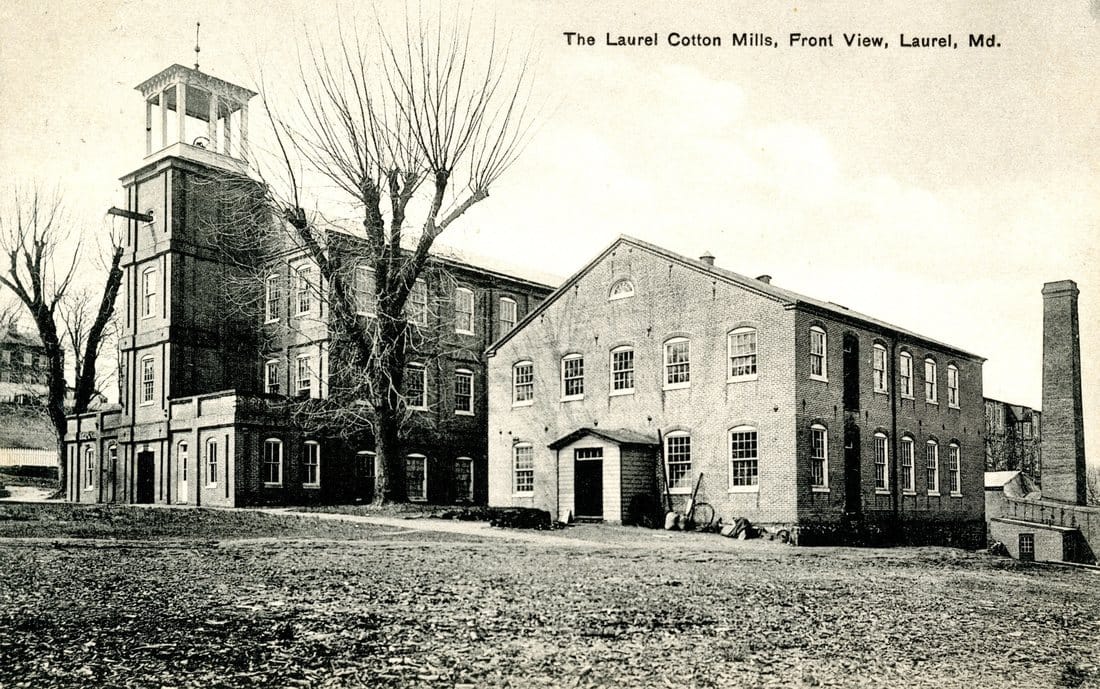True Life: I Am A Laurel Mill Worker
The exhibit explored Laurel’s history as a mill town and the community’s early growth. Using a real 1870s family to tell the story, it introduced visitors to the lives and experiences of the hundreds of men, women and children who worked in town’s cotton mill between the 1830s-1929, when the mill closed for good.
Using the 10-member Waterman family, selected from 1870s census records, visitors learned about the jobs different members of the family, including its seven children, might have performed at the cotton mill. Visitors were given a card for one of the family members and followed them through the exhibit. An adult visitor might have follow Mark Waterman, 49, who may have worked in the picking room at the mill, where once the cotton bales were moved into the picking room, the cotton was unpacked and debris such as twigs, leaves, and bugs were removed. He might have earned: $7.43/wk or 11 cents/hr. A younger visitor might follow Sarah, his 13 year –old daughter, who may have worked as a creeler in the weaving room, making sure there was a constant supply of fresh bobbins for the cotton emerging from the card frames. She would have earned $4.00/wk or 6 cents/hr. In a paymaster’s section of this room, and in an area in the Museum’s downstairs, visitors learn firsthand what these wages might have purchased.
The exhibitions’ second area re-created an 1870s mill workers home in the Laurel Museum’s building. This was the first time that the Laurel Historical Society re-created millworkers' quarters. Housing 10 people (9 family members and one other individual) the space would likely have been very crowded, with multiple children sharing beds and bedrolls. In addition to bedding, and trunks to store items, the space includes 3 kinds of lighting (kerosene, candle and oil), 2 types of heating (wood and coal), a chamber pot, sewing implements, fishing rod, baseball bat, clothing, and other items of everyday life that might have been present in a mill family home. The Laurel Museum building was originally 4 separate apartments, with individual kitchens for each family in the basement. The re-creation also included a basement kitchen set-up as the 1870s family might have had, and where, the exhibit speculates, Virginia Bradley, a 25 year-old, white female listed as living with the family, might have slept.
Notes LHS Executive Director Lindsey Baker: “This exhibit answers the question that we are often asked when people enter the Museum “Who lived here?”. In ‘True Life: I’m a Laurel Mill Worker’ we’ve explored the lives of the people who may have lived in our house and we hope to give our visitors a glimpse into the hard work these people put in over one hundred years ago.”
True Life: I am a Laurel mill worker ran through December, 2012.
Check Us Out in the Press:
Our Opening was featured on WAMU's Art Beat. Check it out here.
The Gazette ran a great article following our exhibit opening. Check it out here.
The Laurel Leader also featured a great article on us. Check it out here.
Interested in learning more?
Check out these resources:
General Resources on the 19th Century:
About the 1870s
Researched and compiled by Roberta A. Freeman, The Star Barn Project Director and Curator December 14, 2007
Teaching History. Org
Variety of vetted materials on the 19th century
Harper's Weekly
19th century popular publication
Popular history of household objects
The Library of Congress.
All collections related to Lewis Hine, an early 20th century worker for the National Labor Committee.
Resources on Mill and Labor History:
Report of the Bureau of Statistics of Labor, 1871
Massachussetts report covering quite a bit about Mill Labor.
Pages 86-98 Strike Information
Pages 255-272 Wage Information, Hours of Labor, Price of Board, Time for Dinner, Education
Pages 459-508 Home and Work Life--what they could afford, price of rent, testimonies, heat of rooms, health of workers, sanitary conditions of home life, half-time schools, etc
Pages 557-568 Hours of labor and recommendations
Pages 582-587 Bios of workers including hours, wages, etc
The History Place
Focus on Lewis W. HineMornings on Maple Street: Lewis Hine Project
Further information on the people in Lewis Hine's images.
Work in a textile mill.
Part of the Learn NC project. An excerpt from "Like a Family: The Making of a Southern Cotton Mill World"
More about Mill Village and Factory Life
More Excerpts from "Like a Family: The Making of a Southern Cotton Mill World"
The War between Capital and Labor
Part of the Academic American History Project.
Contemporary Child Labor Resources:
The Child Labor Coalition
Unicef, Child Protection
Human Rights Watch
HRW Report on Child Labor in US Agriculture
International Labour Organization
ILO’s International Programme on the Elimination of Child Labour (IPEC)
Child Labor Public Education Project
Part of the Child Labor Public Education Project of the University of Iowa Labor Center and Center for Human Rights.
Videos on Related Topics:
The History of Laurel
A brief video by our Junior Docents
The Industrial Revolution
Running a Rebuild Grist Mill
Winnsboro Cotton Mill Blues
Life at the Mill
The Industrial Revolution and Lowell Mills
Interesting Related Exhibits:
Communities in a Changing Nation: The Promise of 19th Century America
National Museum of American History
Montpelier Mansion
Historic House located in South Laurel
George Nye and His Diaries
Previous exhibit at the Laurel Museum
Horace Capron
Online exhibit for the Laurel Museum
Lowell National Historical Park
Located in MA, but there are a number of great resources online
Using the 10-member Waterman family, selected from 1870s census records, visitors learned about the jobs different members of the family, including its seven children, might have performed at the cotton mill. Visitors were given a card for one of the family members and followed them through the exhibit. An adult visitor might have follow Mark Waterman, 49, who may have worked in the picking room at the mill, where once the cotton bales were moved into the picking room, the cotton was unpacked and debris such as twigs, leaves, and bugs were removed. He might have earned: $7.43/wk or 11 cents/hr. A younger visitor might follow Sarah, his 13 year –old daughter, who may have worked as a creeler in the weaving room, making sure there was a constant supply of fresh bobbins for the cotton emerging from the card frames. She would have earned $4.00/wk or 6 cents/hr. In a paymaster’s section of this room, and in an area in the Museum’s downstairs, visitors learn firsthand what these wages might have purchased.
The exhibitions’ second area re-created an 1870s mill workers home in the Laurel Museum’s building. This was the first time that the Laurel Historical Society re-created millworkers' quarters. Housing 10 people (9 family members and one other individual) the space would likely have been very crowded, with multiple children sharing beds and bedrolls. In addition to bedding, and trunks to store items, the space includes 3 kinds of lighting (kerosene, candle and oil), 2 types of heating (wood and coal), a chamber pot, sewing implements, fishing rod, baseball bat, clothing, and other items of everyday life that might have been present in a mill family home. The Laurel Museum building was originally 4 separate apartments, with individual kitchens for each family in the basement. The re-creation also included a basement kitchen set-up as the 1870s family might have had, and where, the exhibit speculates, Virginia Bradley, a 25 year-old, white female listed as living with the family, might have slept.
Notes LHS Executive Director Lindsey Baker: “This exhibit answers the question that we are often asked when people enter the Museum “Who lived here?”. In ‘True Life: I’m a Laurel Mill Worker’ we’ve explored the lives of the people who may have lived in our house and we hope to give our visitors a glimpse into the hard work these people put in over one hundred years ago.”
True Life: I am a Laurel mill worker ran through December, 2012.
Check Us Out in the Press:
Our Opening was featured on WAMU's Art Beat. Check it out here.
The Gazette ran a great article following our exhibit opening. Check it out here.
The Laurel Leader also featured a great article on us. Check it out here.
Interested in learning more?
Check out these resources:
General Resources on the 19th Century:
About the 1870s
Researched and compiled by Roberta A. Freeman, The Star Barn Project Director and Curator December 14, 2007
Teaching History. Org
Variety of vetted materials on the 19th century
Harper's Weekly
19th century popular publication
Popular history of household objects
The Library of Congress.
All collections related to Lewis Hine, an early 20th century worker for the National Labor Committee.
Resources on Mill and Labor History:
Report of the Bureau of Statistics of Labor, 1871
Massachussetts report covering quite a bit about Mill Labor.
Pages 86-98 Strike Information
Pages 255-272 Wage Information, Hours of Labor, Price of Board, Time for Dinner, Education
Pages 459-508 Home and Work Life--what they could afford, price of rent, testimonies, heat of rooms, health of workers, sanitary conditions of home life, half-time schools, etc
Pages 557-568 Hours of labor and recommendations
Pages 582-587 Bios of workers including hours, wages, etc
The History Place
Focus on Lewis W. HineMornings on Maple Street: Lewis Hine Project
Further information on the people in Lewis Hine's images.
Work in a textile mill.
Part of the Learn NC project. An excerpt from "Like a Family: The Making of a Southern Cotton Mill World"
More about Mill Village and Factory Life
More Excerpts from "Like a Family: The Making of a Southern Cotton Mill World"
The War between Capital and Labor
Part of the Academic American History Project.
Contemporary Child Labor Resources:
The Child Labor Coalition
Unicef, Child Protection
Human Rights Watch
HRW Report on Child Labor in US Agriculture
International Labour Organization
ILO’s International Programme on the Elimination of Child Labour (IPEC)
Child Labor Public Education Project
Part of the Child Labor Public Education Project of the University of Iowa Labor Center and Center for Human Rights.
Videos on Related Topics:
The History of Laurel
A brief video by our Junior Docents
The Industrial Revolution
Running a Rebuild Grist Mill
Winnsboro Cotton Mill Blues
Life at the Mill
The Industrial Revolution and Lowell Mills
Interesting Related Exhibits:
Communities in a Changing Nation: The Promise of 19th Century America
National Museum of American History
Montpelier Mansion
Historic House located in South Laurel
George Nye and His Diaries
Previous exhibit at the Laurel Museum
Horace Capron
Online exhibit for the Laurel Museum
Lowell National Historical Park
Located in MA, but there are a number of great resources online


